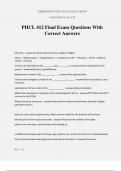©BRIGHTSTARS EXAM SOLUTIONS
11/16/2024 10:16 AM
PHCL 412 Final Exam Questions With
Correct Answers
HPA Axis - answer✔used to respond to stress (fight or flight)
Stress -> Hippocampus -> Hypothalamus -> Vasopressin, CRF -> Pituitary -> ACTH -> Adrenal
Cortex -> Cortisol
Cortisol can feed back to the ________ and _________ to reduce further stimulation of the
system - answer✔pituitary, hypothalamus
Aldosterone is made in the _______ _____- - answer✔zona glomerulosa
Cortisol and androgens is made in the ___________/______ - answer✔zona fasciculata / zona
reticularis
epinehprine / NE are made in the _____________ - answer✔adrenal medulla
differential expression of enzymes in the adrenal gland is due to - answer✔CYP11B1 and CYP17
(cortisol in the ZF/ZR)
Maastricht acute stress test - answer✔men tend to release cortisol faster and with a higher
peak than women
mice can raise cortisol significantly, which remains raised for the duration of the stress
diurnal cycle of serum glucocorticoids - answer✔lowest in the middle of the night
peaks in the morning-- possible helps with waking up
no difference between girls and boys, age, puberty, etc. but lots of variance in individual levels
stress (increases/decreases) glucocorticoid release into blood - answer✔increases
1|Page
, ©BRIGHTSTARS EXAM SOLUTIONS
11/16/2024 10:16 AM
typically resolves quickly; inappropriate stress response can result in too much/too long, or
weak HPA response
repeated stress can lead to ___________, but some forms of chronic stress (severe pain, blood
loss, hypoglycemia) can lead to no _____ - answer✔habituation, habituation
in both cases, a novel stress can cause a hyper-response of the HPA axis
corticosteroids ____________, increase short-term memory, maintain BP, _________
inflammation, help with fetal lung development - answer✔regulate energy metabolism,
inhibit inflammation
Addison's Disease - answer✔corticosteroid deficiency
low blood sugar, low bp, weakness, muscle/join pain, skin darkening / vitiligo, salt craving,
nausea/diarrhea, depression
Cushing's Syndrome - answer✔corticosteroid overload
skin thinning, depression / mood swings, memory loss/learning disability, muscle wasting, poor
wound healing/suppressed immune system, hypertension, diabetes, osteoporosis, anovulation
cortisone was isolated in the 1940s and used for ___________ for the first time in 1948 --
quickly becoming a widely used drug - answer✔rheumatoid arthritis
therapeutic uses of corticosteroids - answer✔allergic reactions
collagen-vascular disorders
inflammation of bones/joints
eye diseases
gastrointestinal disease
hematologic disorders
system inflammation
pulmonary disease
2|Page
, ©BRIGHTSTARS EXAM SOLUTIONS
11/16/2024 10:16 AM
neurologic disorders
organ transplants
renal disorders
skin diseases
thyroid diseases
misc
adverse effects of corticosteroids - answer✔infections
myopathy
neuropsychiatric symptoms, HPA insufficiency
weight gain/obesity, fluid retention, edema, cushing syndrome, insulin resistance
gastric ulcer
hirsutism, skin thinning
cataracts, glaucoma
cardiovascular risk
glucocorticoids regulate 10-20% of genes in your body, binding to _________ ________ inside
cells - can be alpha (active) or beta (blocks alpha) - answer✔glucocorticoid receptors (GR)
glucocorticoids bind with great affinity to _______________ in plasma, not very well to albumin
- answer✔corticosteroid binding globulin (CBG)
in the cell, glucocorticoids bind to their receptor, cause ___________, ___________ to the
nucleus and bind to DNA to regulate transcription of target genes - answer✔dimerization;
translocate
regulation of genes by the GR can either involve __________ of target genes, or
_______________ (messing up other transcription factors)
Net result: increase in anti-inflammatory gene expression, decrease in pro-inflammatory gene
expression - answer✔transactivation; transrepression
Islet of Langerhans cells in the pancreas are responsible for: - answer✔insulin and glucagon
release
3|Page




